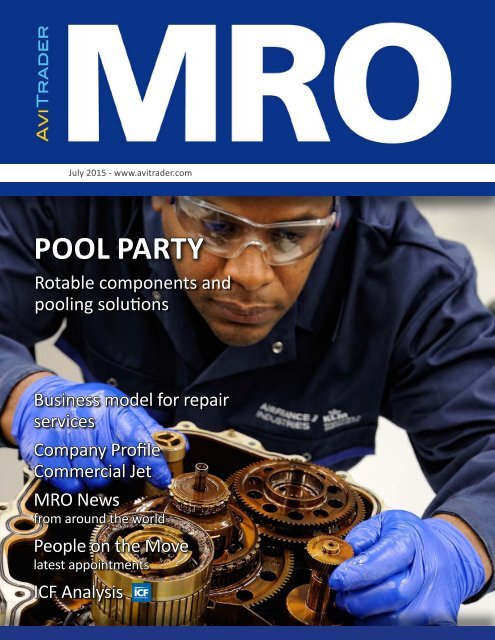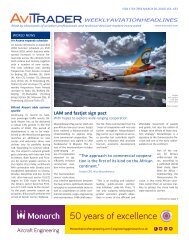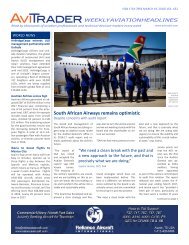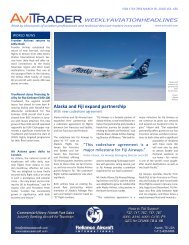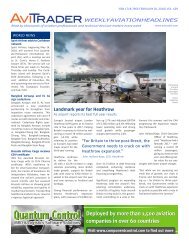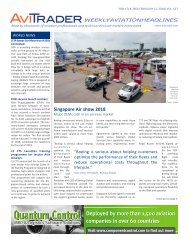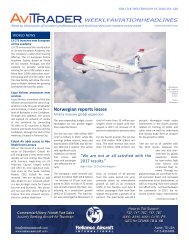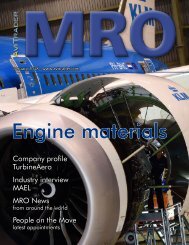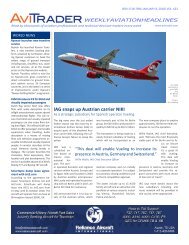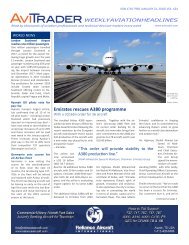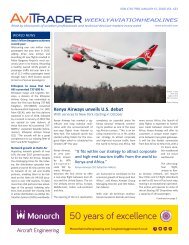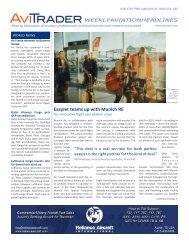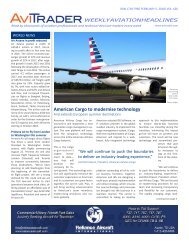AviTrader_Monthly_MRO_e-Magazine_2015-07
AviTrader_Monthly_MRO_e-Magazine_2015-07
AviTrader_Monthly_MRO_e-Magazine_2015-07
You also want an ePaper? Increase the reach of your titles
YUMPU automatically turns print PDFs into web optimized ePapers that Google loves.
July <strong>2015</strong> - www.avitrader.com<br />
POOL PARTY<br />
Rotable components and<br />
pooling solutions<br />
Business model for repair<br />
services<br />
Company Profile<br />
Commercial Jet<br />
<strong>MRO</strong> News<br />
from around the world<br />
People on the Move<br />
latest appointments<br />
ICF Analysis
Editor‘s Page<br />
2<br />
Just ‘plane’ stupid!<br />
The climate change protesters known as “Plane<br />
Stupid” who disrupted operations at London<br />
Heathrow recently brought to light once again<br />
the ease at which unwanted forces can reach<br />
close vicinity to a runway and aircraft especially<br />
in light of the high security alert the UK and other<br />
parts of Europe are under.<br />
A dozen activists cut through the wire perimeter<br />
fencing at 3:30 a.m. Monday July 13 before creating<br />
a human chain on Heathrow’s northern runway.<br />
The incursion comes less than two weeks after<br />
a government-backed study named Heathrow<br />
as the best option for a new London runway.<br />
While airports should be considerate of environmental<br />
issues I feel these protestors are causing<br />
unnecessary disruption. Their attention seeking<br />
antics will result in nothing but added costs to<br />
airports, airlines and the travelling public – an<br />
industry the accounts for billions for most developed<br />
economies. Their reasoning was to target<br />
“frequent travellers and those that travelled for<br />
unnecessary reasons,” which is in itself is ridiculous.<br />
The incursion is an embarrassment for Heathrow<br />
and security forces in the UK and now airports<br />
across Europe have been reassessing the<br />
protection of miles of fencing. Independent air<br />
transport consultant John Strickland said the<br />
protesters entered the runway when flights were<br />
restricted, but he added they must have known<br />
they would “have an impact when the airport<br />
opened”.<br />
All very disturbing!<br />
Keith Mwanalushi<br />
Editor<br />
Published monthly by<br />
<strong>AviTrader</strong> Publications Corp.<br />
Suite 305, South Tower<br />
5811 Cooney Road<br />
Richmond, British Columbia V6X 3M1<br />
Canada<br />
Email: p.jorssen@avitrader.com<br />
Tel: +1 (424) 644-6996<br />
www.avitrader.com<br />
Editorial<br />
Keith Mwanalushi, Editor<br />
Email: keith@aeropublications.co.uk<br />
Mobile: +44 (0) 7871 769 151<br />
Pooling of rotable parts is increasingly popular.<br />
Photo: AF KLM E&M<br />
Contents<br />
<strong>MRO</strong> and Production News ................................................ 4<br />
Finance News ........................................................... 9<br />
Other News ............................................................. 9<br />
Cover story: Pool-ing power............................................... 11<br />
Company profile: Commercial Jet .......................................... 15<br />
Industry Opinion: Proximity to Aerospace Manufacturers ...................... 16<br />
ICF Opinion: The long march of the Middle East titans ......................... 18<br />
Information Technology .................................................. 20<br />
People on the Move ..................................................... 20<br />
Design<br />
Volker Dannenmann, Layout & Design<br />
Email: volker@dannenmann.com<br />
Mobile: +34 657 218706<br />
Advertising inquiries<br />
Jenny Falk<br />
Head of Sales & Marketing<br />
Email: jenny.falk@avitrader.com<br />
Tel: +49 (0) 8761 3460<strong>07</strong><br />
Registration<br />
<strong>AviTrader</strong> <strong>MRO</strong> is a subscription-free<br />
monthly publication. To receive a<br />
personal copy in your inbox every month,<br />
please click here to subscribe.<br />
Opinion<br />
Please send your comments and queries to<br />
editor@avitrader.com<br />
<strong>AviTrader</strong> <strong>MRO</strong> - July <strong>2015</strong>
Geared up.<br />
Starting now.<br />
Our global service network is ready. Because you have a choice of service providers, we strive to be that choice.<br />
We’re ready now to ensure maximum time on wing for your PurePower ® Geared Turbofan engine with the service<br />
difference only the original manufacturer can bring. We’re geared up. Starting now. PurePowerEngines.com.<br />
Dependable Services
<strong>MRO</strong> and Production News<br />
4<br />
V2500-A5 series, the Beijing-base <strong>MRO</strong> provider<br />
overhauls PW4000 series and RB211-535E4 series,<br />
also provides QEC kit and module change on<br />
CFM56 series.<br />
V2500 disassembly and assembly hands-on training<br />
Ameco’s V2500 capability approved by<br />
authorities<br />
Ameco’s capability application on V2500-A5 series<br />
has been approved by CAAC, FAA and EASA.<br />
Thus, Ameco has been authorized to provide<br />
Photo: Ameco<br />
overhaul and modification on V2500-A5 series.<br />
The service on V2500-A5 series as a new product<br />
will help promote Ameco’s market competitiveness<br />
and support it to serve more customers<br />
at home and abroad. The first engine for overhaul<br />
is scheduled for this month. In addition to<br />
ST Engineering’s Aerospace arm secures<br />
US$920m worth of new contracts in<br />
2Q<strong>2015</strong><br />
Singapore Technologies Engineering (ST Engineering)<br />
reported that its aerospace arm has<br />
secured new contracts worth US$920m in the<br />
second quarter (2Q) of <strong>2015</strong>. These new orders<br />
involve projects ranging from airframe, component<br />
and engine maintenance, to engine wash<br />
and pilot training. The total contract value<br />
includes the recently announced component<br />
Maintenance-By-the-Hour contract worth over<br />
US$100m (approximately S$134.8m) awarded<br />
by Flybe, and the engine maintenance contract<br />
worth around US$350m (approximately<br />
S$472m) from Jet Airways. Included in the<br />
2Q<strong>2015</strong> contracts is a heavy maintenance<br />
agreement for six Airbus A319 aircraft belonging<br />
to an international airline. For component<br />
innovation<br />
are you in?<br />
Over 1,000 airline customers in 42 countries share our drive and ambition<br />
to develop cost-effective new aircraft support programmes.<br />
Join our club: ajw-group.com<br />
Transforming aviation efficiency<br />
24/7 AOG: +44 7831 583 205 or +1 877 780 2008<br />
Please visit us:<br />
ACPC, 29 August – 1 September, New York<br />
Aviation Expo China <strong>2015</strong>, 16-19 September, Beijing<br />
Stand 218, <strong>MRO</strong> Europe <strong>2015</strong>, 13-15 October, ExCel London<br />
<strong>AviTrader</strong> <strong>MRO</strong> - July <strong>2015</strong>
<strong>MRO</strong> and Production News<br />
5<br />
Monarch Aircraft Engineering extends<br />
FAA approval at Birmingham<br />
and Copenhagen facilities<br />
Monarch Aircraft Engineering Limited has extended<br />
their US Department of Transportation<br />
Federal Aviation Administration approval<br />
to their Birmingham and Copenhagen base<br />
maintenance facilities. Monarch Aircraft Engineering’s<br />
FAA approval now covers Luton,<br />
Birmingham, Copenhagen and Manchester<br />
bases. Already maintaining US registered<br />
aircraft at Luton and Manchester, this will<br />
allow the UK based <strong>MRO</strong> to further extend<br />
their service offering to all their base maintenance<br />
facilities.<br />
Wheels Lufthansa Technik<br />
Photo: Lufthansa Technik<br />
Start of construction of Lufthansa<br />
Technik AG’s new wheel and brake<br />
workshop at Frankfurt’s East Harbor<br />
support, ST Aerospace secured several Boeing<br />
737NG landing gear overhaul and exchange<br />
contracts for airline operators in Asia and Oceania.<br />
In terms of engine support, an agreement<br />
was inked for the heavy maintenance of<br />
six CFM56-7B engines for a low-cost carrier in<br />
Southeast Asia. Multiple contracts have also<br />
been sealed with customers in Asia Pacific,<br />
Europe and the US for EcoPower engine wash<br />
services. On pilot training, a three-year contract<br />
has been signed with Tigerair Singapore<br />
for the provision of simulator training services.<br />
In 2Q<strong>2015</strong>, the aerospace sector redelivered a<br />
total of 310 aircraft for airframe maintenance<br />
and modification work. In addition to airframe<br />
redeliveries, a total of 10,850 components, 34<br />
landing gears and 50 engines were processed,<br />
while 1,008 engine washes were conducted for<br />
both commercial and military customers.<br />
Monarch Aircraft Engineering secures<br />
line maintenance contract for Hainan<br />
Airlines<br />
Monarch Aircraft Engineering Limited<br />
(MAEL) announced a line maintenance technical<br />
handling agreement with Hainan Airlines.<br />
The agreement, which commenced on<br />
3rd July <strong>2015</strong> is to provide call out support<br />
to the Chinese operator’s flying program into<br />
Birmingham Airport this summer. Hainan<br />
Airlines, headquartered in Haikou, People’s<br />
Republic of China will operate twice weekly<br />
flights on a Boeing 767-300 aircraft, with 223<br />
seats – 34 in the business cabin and 199 in<br />
economy. The flights will operate from Beijing<br />
to Birmingham each Friday and Monday<br />
to the end of August <strong>2015</strong>.<br />
Lufthansa Technik broke ground on the construction<br />
side of the new wheel and brake<br />
workshop at Frankfurt’s East Harbor. The<br />
company is investing just under €60m in<br />
the new production facility, which fulfills<br />
all requirements for lean production, an ergonomic<br />
working environment and sustainability<br />
in terms of how the building has been<br />
developed and will be operated. The new<br />
facility will be put into service at the beginning<br />
of 2017. It will enable Lufthansa Technik<br />
to continue to grow in the segment of<br />
wheel and brake overhaul. Lufthansa Technik<br />
is thus securing the 130 qualified jobs that<br />
already exist in Frankfurt and is also creating<br />
opportunities for further growth. The most<br />
recent figures showed growth rates at more<br />
than 3% per annum based on the volume of<br />
serviced wheels and brakes. An ultra-modern<br />
Your True Aviation Solution!<br />
(772) 925-8026<br />
www.trueaero.com<br />
6020 99th Street, Sebastian, FL 32958<br />
<strong>AviTrader</strong> <strong>MRO</strong> - July <strong>2015</strong>
<strong>MRO</strong> and Production News<br />
6<br />
workshop with a gross floor area of 14,500<br />
m² will be built on a 35,000 m² plot. Thanks<br />
to optimized processes fully adapted to<br />
maintenance requirements, tailored logistics<br />
and state-of-the-art plant equipment, the<br />
new site enables the cost-effective supply<br />
of wheels and brakes for flight operations,<br />
for Lufthansa and numerous other European<br />
customers in the future.<br />
SR Technics and AerFin to launch Beyond.Fleet.Services<br />
SR Technics, a leading provider of technical<br />
services to airlines (Switzerland) and AerFin<br />
(UK), a specialist in providing end-of-life fleet<br />
solutions, have signed an MOU, which underpins<br />
their intention to manage and market<br />
a joint solution branded Beyond.Fleet.<br />
Services. This innovative bundle will extend<br />
the life of the aviation industry’s maturing<br />
fleets of A340-200/300 aircraft by reducing<br />
their operational costs, including engines,<br />
airframe and component maintenance, as<br />
part of a flexible and comprehensive set of<br />
end-of-life managed services. Beyond.Fleet.<br />
Services is designed specifically to reduce<br />
the costs incurred by A340 operators as they<br />
seek to both maximize the life-span and revenue<br />
potential of their existing fleets, while<br />
they manage their eventual withdrawal from<br />
service. Beyond.Fleet.Services combines<br />
flexible leasing schemes and other attractive<br />
cost saving service options for managing engines,<br />
airframes, components and inventory<br />
challenges. It will guarantee fixed-priced<br />
engine and component <strong>MRO</strong> services. There<br />
is also going to be the option for operators<br />
to sell-and-leaseback aircraft and engines<br />
or for Beyond.Fleet.Services to commit to<br />
purchasing aircraft at the end of its lease<br />
or working life. As part of the partnership,<br />
SR Technics will provide the <strong>MRO</strong> services<br />
for CFM56-5C engines and AerFin Ltd the finance<br />
and leasing schemes. In addition, the<br />
two firms will cooperate to ensure that customers<br />
get a steady supply of components.<br />
Beyond.Fleet.Services’ customized packaged<br />
solutions will be wrapped into one contract,<br />
which will provide customers with one single<br />
point of contact and will deliver an integrated<br />
and bespoke end-of-life solution. As part<br />
of its committed preparation for the launch<br />
of Beyond.Fleet.Services, AerFin recently secured<br />
eleven A340-300 aircraft, which will be<br />
disassembled to provide a comprehensive,<br />
cost-effective pool of components to its customers.<br />
Ascent Aerospace awarded Airbus<br />
Beluga assembly line integration contract<br />
Ascent Integration & Automation Group has<br />
been awarded a contract by Airbus for the<br />
Beluga XL Final Assembly Station. The Beluga<br />
XL is an A330 heavily modified to transport<br />
large, oversized aerostructure components<br />
from Airbus supplier facilities to the<br />
Beluga XL final assembly line in Toulouse,<br />
France. Under this contract Ascent Integration<br />
– European Operations, will manage<br />
the design, integration, build and installation<br />
of the equipment and tooling necessary<br />
to assemble this unique aircraft. Ascent Integration<br />
will be responsible for providing<br />
a “turnkey” integrated assembly system incorporating<br />
all the assembly jigs, work platforms,<br />
transport systems, laser metrology,<br />
and tools required to assemble the new Beluga<br />
XL. The project is unique in that, while<br />
only five aircraft will be converted, the assembly<br />
system must deliver the efficiency,<br />
accuracy and worker safety levels required<br />
by Airbus. The contract will conducted from<br />
April <strong>2015</strong> to November 2017.<br />
Vision Systems opens new production<br />
plant dedicated to composite<br />
Vision Systems, an international system supplier<br />
for the aeronautics, automotive and<br />
marine markets, already masters different<br />
industrial processes including Resin Transfer<br />
Molding, thermocompression, infusion,<br />
thermoforming and drape forming. This<br />
production know-how, in addition to that<br />
of mechanics and electronics, enables Vision<br />
Systems to offer complete functional<br />
systems with breakthrough features, most<br />
particularly solar protection solutions, helicopter<br />
doors and windows and cyclic sticks.<br />
Vision Systems’ production comprises not<br />
only leading-edge composite technologies<br />
but also product and process know-hows<br />
such as design engineering, strength calculation,<br />
process engineering, prototyping,<br />
tooling and pre-series, before the launch<br />
of serial production. In order to better respond<br />
to the growing need of its customers<br />
in terms of composite products integration,<br />
Vision Systems is setting up a new production<br />
unit that will specifically produce composite<br />
parts. The new composite plant will<br />
come and reinforce Vision Systems’ existing<br />
industrial facilities from drape forming to<br />
machining, thus strengthening the control of<br />
the product developments from beginning to<br />
end. A 1000 m2 dedicated area will see the<br />
light of day at Brignais’s site (main site of the<br />
group) and will be fully operational by the<br />
end of the year.<br />
<strong>AviTrader</strong> <strong>MRO</strong> - July <strong>2015</strong>
MAINTAINING YOUR PEACE OF MIND<br />
BACKED BY OVER 200,000 COMPONENT REPAIRS EACH YEAR.<br />
With industry-leading operating reliability and more than 30 years of Component <strong>MRO</strong> service-expertise,<br />
our dedicated, experienced and certified team is fully equipped to handle all your component maintenance<br />
needs. Delta TechOps tests, repairs, overhauls and modifies more than 200,000 components every year,<br />
representing more than 8000 different part numbers of 35+ ATA chapters and including:<br />
Avionics Engine QEC LRU Composites and Sheet Metal<br />
Hydraulics Pneumatics Fuel and Oil<br />
Delta TechOps’ ISO 9001 Certified services range from single Repair-and-Return to comprehensive<br />
Inventory Exchange programs.<br />
Covering Boeing, Airbus and McDonnell Douglas fleets, our team of experts<br />
shares one uncompromising goal: to provide you with the highest quality,<br />
most cost-effective service. All with the fastest possible turnaround.<br />
Search our catalog for a complete list of our repair capabilities<br />
and submit your RFQ right from there. And to see what sets<br />
Delta TechOps apart, visit deltatechops.com/components<br />
or call +1-404-773-5192 to contact us.
<strong>MRO</strong> and Production News<br />
8<br />
acquired by Cathay Pacific. Cathay Pacific’s<br />
A350 XWB fleet will include 22 A350-900s<br />
and 26 of the larger A350-1000s, for operation<br />
on long- and medium-haul services.<br />
Vietnam Airlines signs first Airbus<br />
Flight Hour Services (FHS) agreement<br />
for A350 XWB<br />
Airbus A330 Completion and Delivery Centre to be built in Tianjin<br />
Airbus and Chinese partners agree on<br />
wide-body cooperation<br />
Airbus and its Chinese partners, namely the<br />
Tianjin Free Trade Zone Investment Company<br />
(TJFTZ) and the Aviation Industry Corporation<br />
of China (AVIC), have signed a framework<br />
agreement on setting up an A330 Completion<br />
and Delivery Centre (C&DC) in Tianjin, China,<br />
taking the partnership between Airbus and<br />
China a further step forward following the<br />
successful establishment of an A320 Family<br />
Final Assembly Line and Delivery Center in<br />
the Chinese city. The framework agreement<br />
firms-up the Letter of Intent signed by the<br />
three parties last year. The A330 C&DC Tianjin<br />
will be located near the site of the Airbus<br />
A320 Family Final Assembly Line in Tianjin.<br />
The C&DC will cover the aircraft completion<br />
activities including reception, cabin installation,<br />
aircraft painting, engine run and flight<br />
test, as well as aircraft delivery and customer<br />
flight acceptance. Under the project,<br />
the A330 Family aircraft to be completed at<br />
the A330 C&DC Tianjin will be assembled in<br />
Toulouse but will be painted and have their<br />
Photo: Airbus<br />
cabin furnished and installed in Tianjin. On<br />
the same occasion, Airbus has also signed a<br />
Letter of Intent with AVIC on cabin development<br />
cooperation and procurement frame<br />
contract with Zhejiang Xizi Aerospace Fastener<br />
Co., Ltd for design, development, manufacturing,<br />
and supply of standard fastener<br />
parts.<br />
First A350 XWB for Cathay Pacific is<br />
taking shape<br />
Assembly of the first A350-900 for Cathay<br />
Pacific Airways is progressing well at Airbus’<br />
A350 XWB Final Assembly Line (FAL) in Toulouse,<br />
France. Following the fuselage section<br />
joining phase, the wings, the horizontal and<br />
vertical tailplane as well as tail cone have<br />
been joined to the fuselage. Following this,<br />
the aircraft will move to the next assembly<br />
station for structural completion, ground<br />
testing and start of cabin installation. The<br />
aircraft is scheduled for delivery early next<br />
year and will be the first of 48 A350 XWBs<br />
Vietnam Airlines has selected Airbus to provide<br />
Flight Hour Services (FHS) for its new<br />
fleet of 14 A350-900s on order. With this<br />
contract, Vietnam Airlines becomes the first<br />
A350 XWB operator to select Airbus FHS.<br />
The agreement, which will run for 12 years,<br />
provides an extensive scope including A350<br />
line replaceable units (LRUs), guaranteed<br />
spare parts availability through a pool access<br />
service at Vietnam Airlines’ main base and<br />
selected outstations. The signature of this<br />
FHS agreement took place on the occasion<br />
of the arrival of the first A350 XWB for Vietnam<br />
Airlines in Hanoi. Mr. Nguyen Tan Dung,<br />
Prime Minister of Vietnam and a number of<br />
European Ambassadors were present at the<br />
ceremony.<br />
STG Aerospace responds to customer<br />
demand with new US facility in Miami<br />
STG Aerospace, a world leader in pioneering<br />
aircraft lighting technologies, has opened a<br />
new US manufacturing and warehousing facility<br />
in Miami. Located adjacent to the Miami<br />
International Airport runway, the new<br />
building has double the space of the company’s<br />
previous US premises. This significant<br />
investment in expansion reflects growing<br />
demand throughout the Americas for STG<br />
Aerospace products and has been specifically<br />
designed to serve quickly and more<br />
efficiently. The new facility will also ensure<br />
that STG Aerospace can manufacture its latest<br />
product innovations within the US as well<br />
as the UK.<br />
Aircraft Parts Aftermarket Sales and Purchasing<br />
Actively Seeking to Purchase Aircraft for Teardown<br />
Aircraft Parts Consignment<br />
Terry Hix | thix@relianceaircraft.com<br />
(512) 439-6988 | Austin, TX<br />
Nose to Tail Support: 737, 747, 757, 767, A300,<br />
A310, A320, QEC available for CFM56-7B & -5B<br />
<strong>AviTrader</strong> <strong>MRO</strong> - July <strong>2015</strong>
Finance News<br />
9<br />
Alcoa reports solid second quarter <strong>2015</strong> profits<br />
Lightweight metals leader Alcoa reported solid second quarter <strong>2015</strong><br />
results as the Company’s transformation showed strong progress.<br />
Profitability from Alcoa’s growing aerospace and automotive businesses<br />
increased year-over-year as mid and downstream investments<br />
delivered positive impact. In the upstream, the Primary Metals business<br />
was resilient in the face of market headwinds and the Alumina<br />
business delivered its strongest first half results in eight years. Alcoa<br />
reported second quarter <strong>2015</strong> net income of US$140m including<br />
US$143m in restructuring-related charges, primarily to optimize the<br />
Company’s upstream portfolio. Year-over-year, second quarter <strong>2015</strong><br />
results compare to net income of US$138m in second quarter 2014.<br />
Excluding special items, second quarter <strong>2015</strong> net income grew to<br />
US$250m up 16% from US$216m in the year-ago period. Second quarter<br />
<strong>2015</strong> revenue rose to US$5.9bn, from US$5.8bn in second quarter<br />
2014, up 1% year-over-year. Organic growth in aerospace, automotive<br />
and alumina, combined ith acquisitions, grew second quarter revenue<br />
by 12.7%. This profitable growth more than offset an 11.7% decline<br />
in revenue caused by closing and divesting lower-margin businesses<br />
and market headwinds.<br />
Rolls-Royce updates <strong>2015</strong> guidance<br />
Rolls-Royce updated its <strong>2015</strong> guidance, including a preview of its expected<br />
half-year results. In Civil Aerospace, Rolls-Royce continues to<br />
expect <strong>2015</strong> underlying revenue and profit within the guided range<br />
provided in February of £7,000m to £7,300m and £800m to £900m respectively.<br />
However, the company now expects the impact of reduced<br />
Trent 700 deliveries to be greater than initial estimates, reflecting further<br />
adverse developments in the demand for OE and spare engines<br />
and related pricing. In addition, lower-than-expected demand for<br />
engines to power business jets and a softening regional aftermarket<br />
will also adversely impact profit. These market headwinds should be<br />
balanced by good growth in its widebody aftermarket and a largerthan-expected<br />
benefit from the reversal of a balance sheet provision<br />
on the Trent 1000 launch, as a result of an expected significant improvement<br />
in operating performance, and by improved retrospective<br />
TotalCare contract profitability. The value of the provision release<br />
and contract profitability are expected together to contribute around<br />
£200m, somewhat more than previously expected. Rolls-Royce continues<br />
to expect <strong>2015</strong> underlying profit before tax to be phased more<br />
to the second half than in 2014, led principally by Civil Aerospace and<br />
Power Systems. As a result, first half underlying profit before tax is<br />
expected to be between £390m and £430m, or around 30% of the full<br />
year, compared with roughly 40% in 2014. Free cash flow is expected<br />
to be between £(570)m to £(620)m compared with £(347)m in the<br />
first half of 2014.<br />
PPG completes acquisition of Cuming Microwave<br />
PPG Industries has completed its previously announced acquisition<br />
of Cuming Microwave Corporation based in Avon, Massachusetts,<br />
and its wholly-owned subsidiary Cuming-Lehman Chambers, based<br />
in Chambersburg, Pennsylvania. Financial terms were not disclosed.<br />
The acquisition enhances PPG’s portfolio of aerospace coatings with<br />
specialty coatings and materials that absorb microwaves and radio<br />
waves such as radar. The products are used for military aircraft and<br />
also have applications in electronics, telecommunications, medical<br />
and automotive end-uses.<br />
Other News<br />
Airbus plans to build a second plant in China<br />
after winning an order for at least 45 jets that<br />
underpins its production goals for the widebody<br />
A330, said chief executive Fabrice Bregier.<br />
Airbus has been negotiating for about<br />
18 months to establish an A330 ‘cabin completion<br />
centre’ in China alongside an existing<br />
final assembly plant for smaller A320 jets in<br />
Tianjin.<br />
Elbit Systems regional turboprop aircraft manufacturer<br />
ATR signed an agreement for integrating<br />
ClearVision Enhanced Flight Vision System (EFVS)<br />
with the SKYLENS wearable display onboard the<br />
new ATR-600 series. The system can also be offered<br />
as a retrofit to other ATR ‘-600’ aircraft already<br />
in service. Enhancing flight safety, the new<br />
system will also contribute to the operational<br />
availability of turboprop aircraft may require<br />
operating from airfields lacking sophisticated<br />
infrastructure. Suitable for day and night operations<br />
and in all weather conditions, the system<br />
provides head-up information while minimizing<br />
the dependency on airport instrumentation.<br />
Equipped with the new ClearVision EFVS and<br />
SKYLENS wearable display, aircraft are capable<br />
of take-off and landing in low visibility conditions<br />
and in locations that non EVS-equipped aircraft<br />
previously could not approach. According to the<br />
agreement between the two companies, Clearvision<br />
EFVS will be introduced as an option for<br />
both ATR 42-600 and 72-600 models. ATR will be<br />
the launch customer for SKYLENS, which comes<br />
in substitution of the traditional Head Up Display<br />
(HUD) in this configuration. Certification is<br />
planned in 2017.<br />
Elbit Systems and ATR sign agreement for the Integration of<br />
ClearVision EFVS<br />
Photo: ATR<br />
Blackbird, a full solution designer and developer<br />
of aviation wheel and brake specialty tooling’s,<br />
reported that its newest aviation paint kits are<br />
available for Boeing, Airbus, CRJ, Embraer,<br />
McDonnell Douglas, Beechcraft, Cessna,<br />
Gulfstream, Hawker, Lear & Piaggio for main<br />
wheels, nose wheels and brake assemblies. With<br />
Blackbird’s unique patented maskings, an aircraft<br />
wheel or brake can be masked or unmasked in<br />
less than two minutes – a dramatic savings in<br />
both time and expense over the current method<br />
of wheel and brake painting. The masks snap on<br />
easily and are manufactured to the industry’s<br />
highest standards, ensuring product consistency.<br />
The paint maskings meet OEM specs detailed<br />
in the overhaul manuals and have been tested<br />
and specifically engineered for aircraft wheels<br />
and brakes. Using Blackbird’s paint maskings<br />
eliminates the potential for personal injury, overtime<br />
costs, waste and excessive disposable tape<br />
purchasing. All of Blackbird’s products can be<br />
custom-manufactured to a client’s specifications.<br />
Blackbird’s maskings are currently used in Aviall,<br />
Honeywell, Aerolineas Argentinas, Safran and<br />
Messier-Bugatti’s repair maintenance facilities.<br />
<strong>AviTrader</strong> <strong>MRO</strong> - July <strong>2015</strong>
KEEP<br />
CALM<br />
AND<br />
CARRY<br />
ON<br />
GLOBAL LIVE AOG SERVICE 24/7/365<br />
www.gatelesis.com
Cover story: Rotable pooling solutions<br />
11<br />
Pool-ing power<br />
The flow and planning of rotable or repairable components for parts pooling is seen to be more complex<br />
compared to traditional parts, but do the methods really differ? Keith Mwanalushi looks at the process.<br />
much more complex for an<br />
individual supplier. One<br />
important consideration is<br />
the commonality of parts<br />
within the pool that can<br />
be used by different operators.<br />
The pool operator<br />
must manage configuration<br />
control and strive for<br />
standardisation of work<br />
scopes across different<br />
customers operating the<br />
same aircraft. This will<br />
yield greater synergies and<br />
lower costs for the <strong>MRO</strong>,”<br />
Montreuil analyses.<br />
It might be more economical to replace versus repair in some market conditions.<br />
Repairable parts inventory involves a<br />
string of well-orchestrated activities. In<br />
repair environments, parts rotate from<br />
the aircraft, into repair, and back to the aircraft<br />
in a cyclical process. Such parts are normally<br />
known as rotables or repairables.<br />
In terms of the complexity of dealing with rotables,<br />
Harmen Lanser, components group director<br />
for component product development and<br />
logistics at Air France KLM E&M believes the<br />
flow of rotable components is more complex<br />
than traditional service parts.<br />
“This has several reasons,” Lanser declares.<br />
“Firstly, due to the high cost of the rotables<br />
a much more critical planning is essential to<br />
have a cost effective solution. Too high stock<br />
leads to high costs of capital, too low stock<br />
leads to high costs of AOG services.”<br />
Lancer says the repair supply chain is much<br />
less stable than the new parts supply chain and<br />
variations on demand (removal flow) and on<br />
works to be performed on the rotable leads to<br />
fluctuations in production. “As a consequence,<br />
the required inventory to guarantee the service<br />
level is then higher than for a very stable<br />
supply chain.”<br />
He also says reliability management to manage<br />
and increase the MTBR “Mean Time Between<br />
Removal” is critical to optimise the stock level<br />
and availability level of the rotables. “The supply<br />
chain of rotables is a double loop. The first<br />
loop is acquiring and supplying the serviceable<br />
component to the aircraft, the second loop is<br />
to have the unserviceable returned component<br />
repaired and stored serviceable on stock.<br />
Traditional service items only have the first<br />
loop,” Lanser explains.<br />
Stephane Senechal, VP for supply chain services<br />
at Vector Aerospace Engine Services agrees<br />
that rotables are more complex. “In our case<br />
the variety of different configuration, models<br />
and SB (Service Bulletin) status contribute<br />
greatly to making this process more complex<br />
than simply repairing or replacing.”<br />
“Planning an inventory of spare parts begins<br />
with calculating the demand,” adds Larry Montreuil<br />
VP, asset management and business<br />
development at Werner Aero. “Doing so for<br />
traditional service parts for a manufactured<br />
item considers the breakdown rates, the number<br />
of units in service, the cost and supply of<br />
those parts. The planning process for a pool<br />
of rotable aircraft parts considers these and<br />
many other variables that makes the model<br />
Alejandro Ceballos, manager,<br />
AOG and customer<br />
support at Iberia Maintenance<br />
echoes some similar<br />
views. “ S t o c k<br />
level of this kind of components<br />
has to be calcu-<br />
Photo: Iberia<br />
lated with accuracy due to<br />
its price. This analysis adds complexity to the<br />
material planning. It involves a lot of variables<br />
as current and future fleet size, reliability of<br />
each individual part number, airline strategic<br />
plans and so on.”<br />
Also, the surplus market, depending on the<br />
fleet model, moves quite fast in terms of price.<br />
“This adds even more complexity, since repair<br />
Larry Montreuil VP, asset management and business development<br />
at Werner Aero<br />
<strong>AviTrader</strong> <strong>MRO</strong> - July <strong>2015</strong>
Cover story: Rotable pooling solutions<br />
12<br />
and surplus prices have to<br />
be continuously monitored<br />
to decide if units are beyond<br />
economical repair,”<br />
Ceballos continues.<br />
Tom Covella, group president<br />
at STS Component<br />
Solutions has a slightly different<br />
view –“The flow of<br />
rotable components, in my<br />
opinion, has not drastically<br />
changed over the years,” he<br />
says. “I believe most of the<br />
same principles still apply,<br />
and the planning process<br />
that controls the flow of<br />
rotable components should<br />
not be any more challenging,<br />
or complex, than traditional<br />
methods.”<br />
Ultimately, Covella sees the<br />
reliability of the components<br />
as well as the MTBR<br />
and “Mean Time Between<br />
Failure” (MTBF) as two<br />
driving factors that impact<br />
the <strong>MRO</strong> planning process.<br />
He says the MTBR involves how the component<br />
is established within the airlines’ maintenance<br />
planning schedule. He questions if<br />
this a “hard-time” component that is removed<br />
during scheduled cycle or hourly intervals, or<br />
is this monitored “on condition,” whereby the<br />
component is only removed on failure or inoperable<br />
status?<br />
“With the technology improvements<br />
that are constantly being introduced<br />
in the latest generation aircraft, I do<br />
not see this process becoming any<br />
more challenging,” Covella states.<br />
Deepak Sharma, chief technical officer<br />
at the AJW Group adds: “This may<br />
be complex, but the basic fundaments remain<br />
the same,” Sharma contributes. He continues:<br />
“The complexity of any plan is understanding<br />
the volume flow as we start migrating into new<br />
platform equipment such as the A350, B787<br />
A320 NEO or 737MAX.<br />
“Predicting accurate flow is always challenging<br />
because of the reliability factors, as well as<br />
the diverse solutions open to customers in this<br />
competitive market place. Having more choices<br />
in their hands of where to place or route the<br />
<strong>MRO</strong> work,” says Sharma.<br />
Considering the above opinions, it becomes<br />
To scrap or repair a rotable component is driven by several factors<br />
crucial to decide the right time when to scrap<br />
and remove the rotable item from the pool<br />
programme. “A decision of scrapping an existing<br />
component is made when it’s not reliable<br />
and if the unit has fundamental design problems,<br />
as well as safety concerns,” Sharma indicates.<br />
“However, over the years, the airlines have done<br />
a very effective job of offsetting these costs to<br />
either the OEM’s or PBH suppliers.”<br />
Tom Covella, group president at STS Component Solutions<br />
Lanser from AF KLM E&M observes two reasons<br />
to remove a component from the pool.<br />
Firstly, he says if the cost of repair exceeds the<br />
value of the component (Beyond Economical<br />
Repair) BER. Lanser explains that this BER limit<br />
is set by prices and availability of the rotables<br />
on the surplus market. For aircraft with high<br />
surplus availability he feels it might be interesting<br />
to replace it by a surplus component instead<br />
of repairing.<br />
“Also, when the stock level is higher than the<br />
needed stock level the first next unserviceable<br />
component will be removed from the supply<br />
chain to ensure no cost for repairs are made<br />
Photo: AF KLM E&M<br />
and the stock level is corrected to the right<br />
level. This can be caused by increased MTBR<br />
as result of performing modification to the<br />
component. This can also be caused by a decreasing<br />
fleet size. Dependent on the market<br />
value of the rotable it will be scrapped or put<br />
to surplus,” Lanser says.<br />
At Iberia Maintenance, the decision<br />
to remove a unit from a pool programme<br />
is taken only when there<br />
has been a major modification or a<br />
retrofit programme that makes the<br />
part obsolete and if the maintenance<br />
costs have significantly increased<br />
due to a review of the maintenance<br />
procedures.<br />
Clearly the decision whether to scrap or repair<br />
a rotable component is driven by the<br />
repair cost as a function of the replacement<br />
cost. Montreuil from Werner Aero elaborates:<br />
“Once again, the BER threshold is usually 65%<br />
of the replacement cost. Other factors include<br />
the desired inventory level for that component<br />
in the pool. If inventory is adequate to<br />
cover demand, it may make sense to avoid a<br />
high cost repair and scrap the part, even if no<br />
replacement will be sought. The mod status<br />
of the part should also be considered as this<br />
can affect the market value at a serial number<br />
level.”<br />
<strong>AviTrader</strong> <strong>MRO</strong> - July <strong>2015</strong>
Cover story: Rotable pooling solutions<br />
13<br />
At AF KLM E&M they observe that pooling is<br />
getting more and more necessary to economically<br />
manage rotables. Lanser says the fleet<br />
size needed to justify a stock of rotables for<br />
an aircraft has increased from 25 aircraft for<br />
the 747 to over 100 aircraft for 787 and A350.<br />
“This has to do with on one side the increased<br />
cost of rotables and on the other side the increased<br />
MTBR of the components which increases<br />
the number of slow<br />
moving components.”<br />
On the same issue Sharma<br />
from AJW reminds that rotable<br />
components are a<br />
commodity for an airline or<br />
an <strong>MRO</strong>. He explains that It<br />
is a commoditised product<br />
and the market is consistent<br />
in seeking competitive pricing<br />
on each area whether it<br />
is material or labour. “What<br />
has the most impact is when<br />
non-asset programme businesses<br />
have a surplus of<br />
these commodities which is<br />
sold at a throw away price,<br />
which in turn triggers an<br />
alarm in the market place<br />
and that is the significant<br />
impact the markets see,”<br />
Sharma adds.<br />
The repair supply chain is much less stable than the new parts supply chain.<br />
Senechal from Vector Aerospace adds that<br />
when it [rotable] is obsolete, and when the<br />
repair LT for the component meets the TAT requirement<br />
of the work being performed, the<br />
cost of the repair becomes too close to the replacement<br />
cost or if there is an abundance of<br />
used/serviceable replacement available.<br />
Covella notes that in some cases, if there is excess<br />
of surplus components in the market and<br />
it is more economical to replace versus repair<br />
due to current market conditions, then this<br />
avenue can be explored. In another scenario,<br />
whereby the component is seeing an increase<br />
in unscheduled removals and an erosion of<br />
reliability, he states one must examine if the<br />
increase costs to repair the component can be<br />
offset by the replacement of the rotable component.<br />
“This ‘life-cycle cost analysis’ should be performed<br />
on rotable components to determine<br />
what it will cost to operate and or maintain<br />
over specific time intervals. This analysis will<br />
impact the decision on whether to remove the<br />
component from pools and replace with a new<br />
component. This is a very important process<br />
and something we work closely with our OEM<br />
business partners, airline and <strong>MRO</strong> customers<br />
so that we are all achieving the most effective<br />
life-cycle costs on components,” Covella<br />
stresses.<br />
Seemingly, it’s also important to understand<br />
the role or impact routable items play in the<br />
pooling of components and what impact this<br />
has on the cost of rotables. Covella observes<br />
that rotable components play a large role in<br />
inventory pooling and will impact costs for airline<br />
operators.<br />
“However, over the years, the airlines have<br />
done a very effective job of offsetting these<br />
costs to either the OEM’s or PBH suppliers,”<br />
Covella continues. “The airlines have demanded<br />
that OEM’s take a more aggressive<br />
approach in the warranty periods of rotable<br />
components [up to five years, in some cases]<br />
and establish PBH or pooling programmes that<br />
are heavily focused on rotable component support.<br />
As this shift of ownership has taken place<br />
over the years, the cost of rotables still exists<br />
in the market but the airlines have been able<br />
to transfer this cost of ownership to the OEM’s<br />
and PBH providers,” he further states.<br />
Equally crucial is determining<br />
when to place repair<br />
orders versus when to place<br />
Photo: Iberia orders for new items from<br />
suppliers. Caballos from<br />
Iberia concludes and reminds that the surplus<br />
market is continuously moving and it’s a constant<br />
work for the responsible department to<br />
monitor the difference between surplus and<br />
repair price.<br />
“Depending on the type of contract with the<br />
providers, either fix price or based on time and<br />
material basis, you can decide to issue a repair<br />
order before or after receiving a quotation,” he<br />
states.<br />
In some cases Caballos highlights that the decision<br />
on placing a repair order or ordering a<br />
new item depends on the work that has to be<br />
done. “For example, some unit’s test or repair<br />
prices are within the limits of what we consider<br />
economically feasible, but the overhaul of<br />
those units could be considered beyond economical<br />
repair, if the market price is lower. In<br />
that case, the decision is always taken after the<br />
findings report.”<br />
<strong>AviTrader</strong> <strong>MRO</strong> - July <strong>2015</strong>
Over 50 years of<br />
Aviation Expertise<br />
SUPPORT. SERVICE. SOLUTIONS.<br />
Aerospace Strategy and Market Analysis<br />
<strong>MRO</strong> Strategy and Operations<br />
Aircraft and Asset Management<br />
Airline Network and Fleet Planning<br />
Operations and Supply Chain<br />
Airport Business Advisory<br />
Due Diligence and Transaction Support<br />
visit icfi.com/aviation to learn more<br />
PASSION. EXPERTISE. RESULTS.
Company Profile: Commercial Jet<br />
15<br />
Commercial Jet delivers<br />
Commercial Jet specialises in heavy maintenance and modification services, complete airframe<br />
inspections, freighter conversions, interior modifications and avionics upgrade programmes.<br />
The completed B737-400SF passenger-to-freighter conversion seen in the state-of-the-art, purpose built wide-body Commercial Jet Dothan, Alabama paint hangar.<br />
According to market research reports,<br />
forecasts for airframe heavy<br />
maintenance are predicted to be in<br />
the range of 3% - 5% annual growth rate<br />
over the next 8 to 10 years. Commercial Jet<br />
believes the figure to be closer to 3% annual<br />
growth rate. Commercial Jet is well<br />
positioned both physically and geographically<br />
to service the growing maintenance<br />
needs of passenger and cargo airlines,<br />
aircraft owners, lessors and special operations.<br />
Due to the substantial cost often associated<br />
with ferrying aircraft, our overall<br />
focus is on the North and South American<br />
markets as well as the Central American<br />
and Caribbean regions. In addition to this<br />
Commercial Jet offers lessors efficient locations<br />
to perform transition maintenance<br />
and painting for aircraft transiting to or<br />
from other markets.<br />
Commercial Jet currently operates two<br />
centrally located facilities, one in Miami,<br />
Florida and the other in Dothan, Alabama.<br />
Both locations offer full scheduled and unscheduled<br />
heavy maintenance as well as<br />
modification work including freighter conversions,<br />
interior modifications and avionics<br />
upgrade programmes. Additionally, the<br />
Dothan, Alabama facility has a full service<br />
modern paint facility.<br />
Commercial Jet is well known in the industry<br />
as a top tier provider of passenger-tofreighter<br />
(P-F) conversions. This type of<br />
modification is often linked to heavy maintenance<br />
requirements reducing shop visits<br />
and allowing for time efficient modification<br />
of an aircraft. Having converted over<br />
150 aircraft to date, most including heavy<br />
maintenance, Commercial Jet has enacted<br />
a number of efficiency gains - translating<br />
into real savings and convenience for our<br />
customers.<br />
As the company continues to reflect on<br />
changing market needs, Commercial Jet<br />
now offers maintenance and once the<br />
modification is certified, P-F conversion<br />
services, for the Bombardier Regional Jet.<br />
From Commercial Jet’s perspective, economic<br />
drivers like the availability of used<br />
CRJ’s, affordable fuel prices and continued<br />
economic recovery will drive the continued<br />
use of these aircraft in both passenger<br />
and freighter markets.<br />
In summary, the company believes that<br />
the inherent capacity constraints of an<br />
airlines’ in-house <strong>MRO</strong> results in a general<br />
need to grow outsourced portions of their<br />
maintenance for existing aircraft in order<br />
to accommodate fleet growth.<br />
Commercial Jet is accredited in the United<br />
States, European Union and other international<br />
regulatory certifications.<br />
<strong>AviTrader</strong> <strong>MRO</strong> - July <strong>2015</strong>
Industry Opinion<br />
16<br />
Proximity to Aerospace Manufacturers:<br />
The new business model for repair services<br />
Aerospace manufacturers look to speed repairs while reducing costs by working with international repair services<br />
that offer full service locations in close proximity<br />
Given the increasing cost of ongoing maintenance and repair at any<br />
industrial plant, many aerospace manufacturers are discovering the<br />
value and advantages of working with a repair service that not only<br />
has the size and expertise, but also is as nearby as possible.<br />
Proximity, after all, has many advantages for the manufacturer. First and foremost,<br />
having a repair service company in close proximity means repairs can<br />
be completed faster and the maximum possible uptime maintained. Today,<br />
most manufacturing plants need replacement parts quickly.<br />
Proximity means faster service and reductions in shipping costs.<br />
For plant maintenance departments, the savings achieved by being close to a<br />
reputable repair service companies impacts the balance sheet by extending<br />
the life of plant assets and keeping them in production.<br />
Considering the vast range of parts that need servicing in any given plant - such<br />
as drives, PLC’s, servo motors, CNC machines, spindles, ballscrews, hydraulic<br />
components, robotics, material handling components, valves, safety curtains,<br />
pumps, actuators, and torque tools - the cost savings can amount to millions.<br />
As an example, K+S Services works with United Technologies (UTC), a provider of<br />
high-technology systems and services to the building and aerospace industries.<br />
As is the case in many manufacturing plants, there is ongoing maintenance<br />
of equipment like motors, spindles, and actuators. To minimise manufacturing<br />
downtime, UTC uses nearby K+S Services for some of its repair services.<br />
The fact that they are located within miles of each other helps the repairs get<br />
done quickly.<br />
From a logistics standpoint, turnaround time is minimised by the close proximity.<br />
In some instances a part has been picked up in the morning, fixed, and<br />
returned that same afternoon.<br />
Headquartered in Southgate, Michigan, K+S Services, Inc. is unique in the repair<br />
service business as it pursued a strategic model of expansion by opening<br />
new locations in close proximity to existing major plants, as well as geographic<br />
regions that attract and support U.S.-based manufacturing.<br />
The company now operates eleven facilities across the globe, including the<br />
U.S., Mexico, Canada, and Europe. More than just a store front with a lone representative<br />
that coordinates with a larger office, these repair facilities are fully<br />
functioning shops with managers, technicians and spare parts at every location.<br />
This business model not only delivers all the benefits of high quality repair services,<br />
but provides these services in close proximity to where they are needed.<br />
Building on a strong relationship and performance, K+S was recently awarded<br />
UTC Supplier Gold status by demonstrating “best in class” quality and delivery<br />
performance, implementation of a lean culture, and overall strong customer<br />
Having a repair service in close proximity means repairs can be completed faster and the<br />
maximum possible uptime maintained.<br />
satisfaction. Achieving Competitive Excellence, or ACE, is the UTC operating<br />
system for promoting quality, delivery, efficiency and customer satisfaction.<br />
UTC Supplier Gold is a programme that facilitates and accelerates supplier<br />
performance improvements which recognises suppliers who have achieved<br />
exceptional performance.<br />
“K+S received many customer feedback responses and high customer satisfaction<br />
scores,” said Stephen Bohlman, Director of Supplier Performance,<br />
UTC.” This is a good indication that K+S Services is satisfying their primary<br />
users by operating at best-in-class service levels.”<br />
If physical proximity in terms of location has its benefits, there is no relationship<br />
closer than having a repair service representative stationed within the<br />
plant itself.<br />
In K+S’ Smart Total Asset Management Programme (STAMP), customers are<br />
<strong>AviTrader</strong> <strong>MRO</strong> - July <strong>2015</strong>
Industry Opinion<br />
17<br />
assigned a full-time, on-site account manager to serve as a one-stop facilitator<br />
and manager of all repairable assets within a specific plant.<br />
This includes tracking all repairs, expediting when required, shipping or delivering<br />
to and from the nearby repair facility, maintaining database integrity,<br />
streamlining and stabilising procedures, generating a wide variety of reports<br />
and keeping the customer informed throughout the process. The facilitator<br />
works with the plant to establish min and max levels to ensure effective leadtime<br />
fulfillment of repairs and uptime.<br />
When the part arrives at the repair facility, technicians conduct an evaluation<br />
to identify the probable cause of failure, and then repair and test the part per<br />
the manufacturing test procedures. After being repaired the item is tested<br />
with the associated closed loop test system for the specified duration. The<br />
part and its associated documentation are then sent back to the plant.<br />
Proof of the success of this business model rests with the number of corporations<br />
ascribing to it. Major companies such as, Continental, GM, Fire Stone,<br />
Ford, Goodyear, GE Air, Chrysler, and UTC are current STAMP customers. K+S<br />
successfully services well over 800 manufacturers.<br />
Considering the vast range of parts that need servicing in any given plant, such as servo<br />
motors, the cost savings of having a close repair service can amount to milllions.<br />
This success points to a very good reason why the local repair-service model<br />
should see even greater adoption by more aerospace manufacturers in the<br />
immediate future.<br />
Your Worldwide Jet Engine Parts Supplier<br />
Engine stands available for lease<br />
USA: 954-421-2510<br />
sales@tesllc.aero | www.tesllc.aero<br />
4700 Lyons Technology Parkway | Coconut Creek, FL 33<strong>07</strong>3<br />
<strong>AviTrader</strong> <strong>MRO</strong> - July <strong>2015</strong>
ICF Opinion<br />
18<br />
The long march of the Middle East titans<br />
By Jonathan M. Berger, Vice President – Aerospace & <strong>MRO</strong> Advisory – ICF International.<br />
On a recent business trip, I had a last-minute<br />
itinerary change and found myself needing<br />
to travel from Kuala Lumpur to Buenos<br />
Aires. The travel search engine came up with only<br />
a single one-stop option: Emirates via Dubai. And<br />
the price for a business-class seat was very reasonable<br />
given the three day advanced notice. Once<br />
onboard, the quality of the product was impressive;<br />
a 20” TV monitor, electric window shades,<br />
spacious fully lie flat seat – perhaps this grueling<br />
20+ hour journey was not going to be so bad after<br />
all. The meal choices read like a fine dining menu<br />
- a myriad of options with something for all global<br />
palates. The in-flight entertainment (IFE) system<br />
boasted over 2,000 channels of movies, TV shows,<br />
music and games, on demand and in multiple languages<br />
(I was not only able to catch up on a few<br />
episodes of Mad Men, I binge watched a full three<br />
seasons!) As I changed planes in Dubai, I was directed<br />
to the business class lounge that was itself<br />
the size of most airport terminals. Throughout my<br />
subsequent connecting flight to Buenos Aires, I<br />
kept thinking to myself “how can any airline compete<br />
with this”?<br />
I must admit, early on I was skeptical of the business<br />
models of the big three Middle East titans:<br />
Emirates, Qatar, and Etihad. I recall attending the<br />
2003 Paris Air Show when Emirates announced<br />
the acquisition of 23 A380 and 26 Boeing 777 aircraft<br />
on top of its order for 22 A380s and 25 777’s<br />
just one year prior. Etihad and Qatar made similar<br />
purchases worth billions of dollars. My business<br />
instincts could not accept the viability of three<br />
mega-carriers with hubs in small cities that are<br />
geographically so close together that it would be<br />
equivalent to the Florida cities of Miami, Tampa,<br />
and Jacksonville (or Hamburg, Berlin, and Dusseldorf)<br />
all starting their own global airlines. It just<br />
didn’t add up. A decade later, it is clear that my<br />
trusted instincts failed me, as the three Middle<br />
East titans have all seen spectacular growth and<br />
become a force to be reckoned with in the highly<br />
competitive global aviation industry.<br />
Interestingly, the three titan’s business models<br />
have evolved differently as they each have carved<br />
out their own respective growth strategies. Abu<br />
Dhabi-based Etihad Airways has taken the M&A<br />
route, strategically leveraging its cost of (and access<br />
to) capital to acquire major equity holdings<br />
across a network of distressed airlines. Over the<br />
past few years, Etihad has acquired stakes in Air<br />
Berlin, Alitalia, Jet Airways, Virgin Australia, Air<br />
Serbia, and Air Seychelles to name a few. Dohabased<br />
Qatar Airways is the only titan to have<br />
joined one of the powerful global airline alliances,<br />
oneworld, which provides access to passengers<br />
and destinations aligned with partners British Airways,<br />
American Airlines, LATAM, Japan Airlines,<br />
and Cathay Pacific among others. Dubai-based<br />
Emirates Airlines with a fleet plan that includes<br />
over 140 A380s and 300 Boeing 777s has elected<br />
to go it alone. In 2014, its Dubai hub became the<br />
world’s busiest international airport ahead of London’s<br />
Heathrow. Emirates clearly aspires to remain<br />
the dominant carrier in the Gulf region.<br />
While their growth strategies are clearly different,<br />
the titans do share the same core business model;<br />
leveraging their geographic location to connect<br />
Asia to the world – all on a convenient, time saving<br />
one-stop basis, utilizing<br />
the most modern<br />
aircraft, with high quality<br />
service and in-flight<br />
amenities. Given the<br />
growth of Asia’s emerging<br />
economies and<br />
population, with tens of<br />
millions moving into the<br />
middle class every year,<br />
it appears that the business<br />
model is indeed<br />
sound.<br />
Berger - Middle East titans<br />
are on a long, patient march<br />
to an airport near you.<br />
More importantly, the titans share another key attribute<br />
– they take the long view. In hindsight, the<br />
blind spot missed by the skeptics, myself included,<br />
is the time horizon and patience that the titan’s<br />
shareholders have to achieve a satisfactory financial<br />
return on invested capital (ROIC). The Gulf<br />
carriers’ primary goal is to support the development<br />
of their national economies, and therefore<br />
think about ROIC in terms of decades rather than<br />
fiscal quarters. Lastly, unlike their global competitors,<br />
the Middle East titans are not just creating<br />
competitive air carriers - they are building lifestyle<br />
brands exemplified by their sponsorships of<br />
elite marquee sporting events like Formula 1 racing,<br />
professional soccer/football, and even public<br />
transport (e.g. London’s “Emirates Air Line” cable<br />
car). The ubiquitous Gulf carrier branded jerseys<br />
are worn by children from virtually every youth<br />
soccer pitch from Brazil to China. And today’s<br />
FC-Barcelona-jersey-wearing kids are tomorrow’s<br />
potential business travelers.<br />
As a major global aviation consultancy, my employer<br />
ICF is continually asked by the investment<br />
community if the Gulf carriers pose an existential<br />
threat to legacy European, Asian, and US airlines.<br />
My response begins with an emphatic “yes.”<br />
However, before the wolves of Wall Street have<br />
a chance to liquidate their positions in the legacy<br />
carriers, I add that I also believe that legacy carriers<br />
pose an existential threat to the Gulf carriers as<br />
well. In the highly competitive global aviation battlefield,<br />
any carrier who doesn’t feel threatened<br />
by their competitors and loses focus on innovation<br />
and efficiency is doomed to fail.<br />
In terms of <strong>MRO</strong>, the major Middle East carriers each have forged a different path forward.<br />
Photo: Boeing<br />
That said, legacy carriers possess numerous arrows<br />
in their quiver with which to compete effectively<br />
with the Middle East titans, not unlike their<br />
adaptation to the previous “existential threat”<br />
posed by the fast growing low cost carriers (LCCs).<br />
For example, never underestimate the power of<br />
home carrier frequent flyer programs. Much like<br />
<strong>AviTrader</strong> <strong>MRO</strong> - July <strong>2015</strong>
ICF Opinion<br />
19<br />
the face-painting sporting fan zealots blindly loyal<br />
to their hometown clubs, nationalism and the desire<br />
to achieve elite loyalty program status remain<br />
powerful airline marketing tools. In addition, legacy<br />
airlines have the ability to further grow their<br />
alliances and JVs with Asian carriers to overfly the<br />
Gulf mega-hubs.<br />
From a competition standpoint, the titan’s natural<br />
first targets were the struggling European carriers.<br />
Unlike their US counterparts, European carriers<br />
have been slow to restructure and consolidate.<br />
Further, fast growing European LCCs (e.g. Ryanair<br />
and easyJet) continue to capture ever-more market<br />
share. Now that the titans have secured a<br />
presence in most of the major European airports,<br />
it’s fascinating to watch how they are deploying<br />
their newly delivered wide body aircraft. As we<br />
all know, profit margins in the airline business are<br />
razor thin, often with the sale of just one or two<br />
business class seats making difference between a<br />
flight’s profit or loss. Hence it’s intriguing to see<br />
the titans now targeting secondary European airports<br />
in an attempt to poach the connecting business<br />
class traveler from the national carriers. It is<br />
difficult to imagine that the cities of Manchester,<br />
England and Munich, Germany could consistently<br />
fill an A380. But much to the European national<br />
carriers chagrin, Emirates appears to have these,<br />
and other secondary airports, in their cross-hairs.<br />
According to a recent article in the Economist<br />
magazine, Lufthansa’s Frankfurt hub has lost nearly<br />
a third of its market share on routes between<br />
Europe and Asia since 2005, with more than three<br />
million people now flying annually from Germany<br />
to other destinations via Gulf hubs.<br />
With statistics like these, it’s no wonder the major<br />
US carriers have banded together to file a complaint<br />
with the US Department of Transportation<br />
accusing the Gulf carriers of violating the bilateral<br />
Open-Skies agreement. The US majors are hoping<br />
to halt the titan’s US expansion plans until a level<br />
playing field is achieved. Similar to the decadeslong<br />
subsidy dispute between Boeing and Airbus,<br />
it seems that for the time being, the tit-for-tat accusations<br />
between the Gulf carriers and their US<br />
counterparts will continue to play out in the court<br />
of public opinion. For example, Delta Air Lines<br />
CEO Richard Anderson recently gave a speech at<br />
the Detroit Economic Club where he compared<br />
the situation of US carriers to the “unfair trading<br />
practices” that devastated the Big Three auto<br />
manufacturers in the 1980s and 1990s. Regardless<br />
of which side of this corporate drama you believe<br />
has merit, the real winners of this politically<br />
charged dispute will be the respective PR firms,<br />
lobbyists, and lawyers.<br />
That said, a very interesting wrinkle worth noting<br />
is how Qatar Airways responds. Qatar is not<br />
only a oneworld partner with American Airlines,<br />
but also a shareholder in IAG, whose oneworld<br />
member airlines British Airways and Iberia have,<br />
perhaps begrudgingly, publicly sided with Gulf carriers,<br />
stating that “To shield US airlines from their<br />
competitors would be to grant them the biggest<br />
subsidy of all.”. Qatar has already threatened to<br />
leave the alliance, and given Emirates’ successful<br />
go-it-alone strategy, there is good reason to believe<br />
that they are not bluffing.<br />
On the <strong>MRO</strong> front, the titans each have forged a<br />
different path forward. While they leverage their<br />
volume and scale to negotiate competitive support<br />
agreements with the OEMs for engine and<br />
component maintenance, no airframe <strong>MRO</strong> has<br />
the capital required to build facilities capable of<br />
handling Emirates’ wide body fleet. Therefore,<br />
Emirates had no choice but to go-it-alone for its<br />
airframe heavy maintenance requirements. Accordingly,<br />
and in classic Dubai fashion, Emirates<br />
has erected a massive complex of A380-capable<br />
hangars to perform its airframe heavy checks inhouse.<br />
In contrast, Qatar has elected, at least for<br />
the time being, to outsource its airframe heavy<br />
maintenance (while also outsourcing its engines<br />
and components).<br />
Etihad on the other hand, or more appropriately<br />
its owner Mubadala, the investment vehicle of the<br />
Government of Abu Dhabi, has charted a different<br />
<strong>MRO</strong> course. In 2006, Mubadala acquired the<br />
full service global <strong>MRO</strong> leader SR Technics and a<br />
year later assumed control of Gulf Aircraft Maintenance<br />
Company (GAMCO) that was rebranded<br />
as Abu Dhabi Aircraft Technologies (ADAT). Most<br />
recently, in 2014, the airframe heavy maintenance<br />
business of ADAT was transferred to Etihad to become<br />
Etihad Engineering. Today, Etihad relies on<br />
its in-house Etihad Engineering for airframe maintenance<br />
support, on SR Technics for the majority<br />
of its component support, and on engine OEMs<br />
and the Mubadala-owned Turbine Services & Solutions<br />
(TS&S) for engine support.<br />
Given the growing technological complexity of<br />
maintaining new generation aircraft (e.g. A350<br />
and Boeing 787), the transition of metal aircraft to<br />
composites, analogue instrumentation to digital<br />
avionics, and bespoke interiors and IFE systems<br />
which require the craftsmanship of a Swiss watch<br />
maker to maintain, it will be interesting to watch<br />
how Etihad’s relationship with sister company SR<br />
Technics continues to evolve.<br />
Like it or not, the Middle East titans are on a long,<br />
patient march to an airport near you - regardless<br />
of the continent where you live. And they will<br />
continue to disrupt the traditional home-court<br />
advantage enjoyed by the world’s national carriers;<br />
complacency is the enemy, and innovation<br />
the solution. As a frequent international business<br />
traveler, I look forward to continue reaping the<br />
benefits brought on by the competition that Middle<br />
East airline titans are injecting into the global<br />
airline industry.<br />
ICF International provides objective, independent<br />
regulatory, technical, financial, and commercial<br />
guidance to aviation clients, including airlines,<br />
airports, financial institutions, manufacturers,<br />
U.S. federal agencies, international governments,<br />
VIPs, and heads of state.<br />
www.icfi.com/aviation<br />
<strong>AviTrader</strong> <strong>MRO</strong> - July <strong>2015</strong>
Information Technology<br />
20<br />
Global Eagle Entertainment, a market-leading media and connectivity<br />
company to the travel industry, has completed the acquisitions of<br />
Western Outdoor Interactive (“WOI”) and certain assets from RMG<br />
Networks Holding Corporation. Together these deals strengthen<br />
and increase the scope of GEE’s offerings in the digital media and<br />
content services markets, providing GEE with a more integrated<br />
solution to meet the needs of the airline and maritime industries.<br />
Through the acquisition of WOI, based in Mumbai, India, GEE has expanded<br />
both its digital media development expertise and its already<br />
strong presence for apps and games to the inflight entertainment<br />
(IFE) market. WOI brings over 30 years of experience and deep relationships<br />
with leading airlines and aviation hardware providers in<br />
bringing infotainment and specialized software to the airline industry.<br />
In addition, its engineers and creative services provide design,<br />
web and app development expertise that augments GEE’s already<br />
strong platform. GEE expects to realize synergies from this acquisition<br />
through customer relationships, a broader development platform<br />
and integration across its content, connectivity and digital media<br />
platforms. The second acquisition includes certain assets from<br />
RMG Networks, bolstering GEE’s already strong presence for inflight<br />
advertising and sponsorship. By acquiring the rights to certain technologies<br />
and onboarding key personnel, GEE now offers airlines and<br />
advertisers a more robust foundation from which to serve advertising<br />
and sponsorship opportunities via digital media, in either a connected<br />
or offline environment, seatback screen entertainment and<br />
digital signage in airline lounges.<br />
People On The Move<br />
Jeremy Remacha<br />
SR Technics (SRT) Board of Directors<br />
announced the appointment<br />
of Jeremy Remacha, Senior Vice<br />
President from Mubadala Development<br />
Company, the shareholder<br />
of SRT, as its interim Chief Executive<br />
Officer, taking over from<br />
Andre Wall who has decided to<br />
take a new opportunity in the aviation<br />
industry. Remacha and Wall<br />
have worked side by side for over<br />
six years as Remacha has played<br />
an active role in supporting the<br />
company and the Board as the Asset<br />
Manager.<br />
Thomas Chapman<br />
C&L Aerospace has hired Thomas<br />
Chapman, formerly of Gulfstream<br />
and Bombardier Aerospace, as<br />
Senior Vice President of Corporate<br />
Aircraft. In his new role, Chapman<br />
will oversee C&L’s growing corporate<br />
aircraft platform featuring<br />
<strong>MRO</strong>, aircraft sales, management<br />
and charter.<br />
Intrepid Aviation, a privately held commercial aircraft lessor, named<br />
Gerry Aubrey to Senior Vice President – New Aircraft Programs. Mr.<br />
Aubrey joined Intrepid in 20<strong>07</strong> and has held a variety of roles, most<br />
recently as VP Contracts, moving over to VP Aircraft Programs last<br />
year to concentrate on new orders and building/maintaining Intrepid’s<br />
relationships with OEM’s.<br />
GA Telesis UK released that Carsten Holm has been appointed vice<br />
president of technical services. Mr. Holm joins the company after<br />
serving as vice president – technical at Star Air, where he was responsible<br />
for all maintenance contract and lease negotiations as well as<br />
developing engine and airframe ultimate life forecasts. Prior to this<br />
position, Mr. Holm served as Star Air’s director of engineering and<br />
managed engine parts purchasing and engine leasing. In his new role<br />
at GA Telesis, Mr. Holm will work in support of the company’s Asset<br />
Management Group and will oversee all technical operations for its<br />
fleet of leased commercial aircraft and engines.<br />
The Boeing Board of Directors<br />
has elected Dennis A. Muilenburg<br />
the company’s 10th Chief<br />
Executive, succeeding W. James<br />
McNerney, who held the position<br />
for the past 10 years.<br />
Muilenburg, who has served<br />
as Boeing President and Chief<br />
Operating Officer since 2013,<br />
becomes President and CEO on<br />
July 1st. Muilenburg is a 30-year<br />
company veteran. Along with<br />
Boeing Commercial Airplanes<br />
President and CEO Raymond L.<br />
Conner, he also has served since<br />
2013 as Company Vice Chairman.<br />
Dennis A. Muilenburg<br />
<strong>AviTrader</strong> <strong>MRO</strong> - July <strong>2015</strong>


